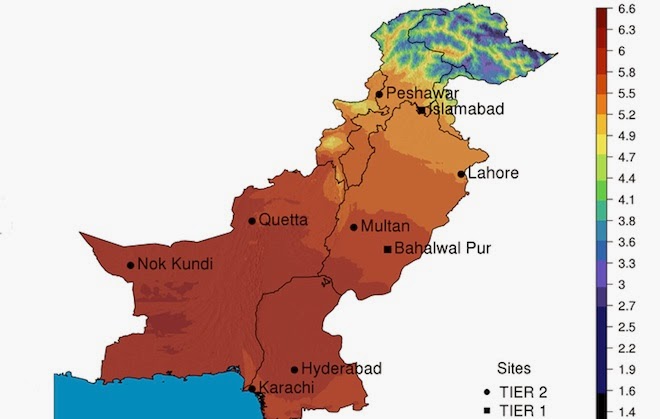Pakistan has tremendous potential for harnessing wind power, solar energy, biomass and other renewable energy resources to help reduce power cuts and improve access to modern energy services. But the country lacks the high quality resource data at a national scale that is needed to take full advantage of these sources of clean energy.
For the past year, the World Bank and Pakistan’s Alternative Energy Development Board have been working together to map renewable energy resources across the entire country. The project, supported by the World Bank’s Energy Sector Management Assistance Program (ESMAP), will measure Pakistan’s potential for wind, solar and biomass energy by using ground-based data collection, GIS analysis, and geospatial planning. It is part of a broader Renewable Energy Resource Mapping initiative covering 12 countries.
Concluding the first phase of the project, initial maps of solar and wind potential for Pakistan were presented to the government and other stakeholders at an October 15 workshop in Islamabad. The result of months of computer-intensive modeling, these maps represent a significant improvement over previous efforts due to computational advances over the last decade. The maps are based on satellite data and global atmospheric models covering a 10 year period, and can be used to estimate the likely solar or wind potential at any point in the country.
However, to get to the level of confidence required by commercial developers, these modeling results must be compared against actual solar and wind measurements taken from ground-based stations.
A major part of the ESMAP renewable energy mapping initiative is to collect ground-based measurement data for a period of up to two years. This data is then used to improve the models, leading to the production of solar and wind atlases with a margin of error of as low as 5 percent. These in turn can be used by governments to set tariffs and guide the strategic development of renewable energy, and by commercial developers to carry out feasibility studies, leading to development of solar and wind power plants.
Pakistan is the first of the 12 country-level activities to reach the milestone of commissioning a measuring station. A high precision solar measuring station was inaugurated at the site of the Quaid-e-Azam Solar Park, near Bahawalpur in Punjab Province on October 18, 2014. This park is home to the first of many solar farms that are being planned in Pakistan, with 100 megawatts of capacity currently being constructed and due to begin generating electricity in early 2015.
By the end of the project, nine solar stations will be installed in Pakistan, of which two (in Bahawalpur and Islamabad) will be ‘high precision’ stations. The other seven standard precision stations are also very accurate, but are more suitable for remote locations, requiring only weekly cleaning and getting their small power requirement from a solar panel. All stations take multiple readings, including solar irradiance, temperature, air pressure, and wind speed. The data is transmitted daily using a modem, with 10 minute average values available from each sensor. At the time of writing this article, a total of four sites have been commissioned in Pakistan, including the one at Bahawalpur.
Over the next few months, the wind measurement campaign will also get underway, with around 15 sites planned across Pakistan. Wind measuring sites involve installation of a lattice tower up to 80m high, with anemometers installed at various heights to take highly accurate wind speed readings.
There is very strong demand from commercial developers and government stakeholders for access to the data that will be generated under the Pakistan project. The World Bank project team is working to design an open data solution that will allow the data to be accessed on a cost-free basis in near real-time.
The $22.5 million, five-year ESMAP Renewable Energy Resource Mapping program covers wind, solar, small hydro and biomass mapping, with each project designed according to specific country needs and the resources available. Besides Pakistan, work is currently underway in Ethiopia, Indonesia, Lesotho, Madagascar, Malawi, Maldives, Nepal, Papua New Guinea, Tanzania, Vietnam, and Zambia.
